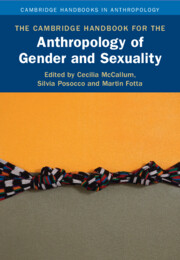Book contents
- The Cambridge Handbook for the Anthropology of Gender and Sexuality
- Cambridge Handbooks in Anthropology
- The Cambridge Handbook for the Anthropology of Gender and Sexuality
- Copyright page
- Contents
- Contributors
- 1 Introduction to The Cambridge Handbook for the Anthropology of Gender and Sexuality
- Part One Openings and Orientations
- 2 Remixing Feminist Epistemology and Methodology
- 3 Critical Ethnography as a Collective Feminist Project
- 4 Kinship and Relatedness as Vital Lens
- 5 Reframing the Social, Rethinking the Body, Confronting Biologism
- Part Two Knowledges and Domains
- Part Three Resistances and Intersections
- Part Four Desires and Relations
- Part Five Recursivities and Futures
- Name Index
- Subject Index
- References
3 - Critical Ethnography as a Collective Feminist Project
from Part One - Openings and Orientations
Published online by Cambridge University Press: 29 September 2023
- The Cambridge Handbook for the Anthropology of Gender and Sexuality
- Cambridge Handbooks in Anthropology
- The Cambridge Handbook for the Anthropology of Gender and Sexuality
- Copyright page
- Contents
- Contributors
- 1 Introduction to The Cambridge Handbook for the Anthropology of Gender and Sexuality
- Part One Openings and Orientations
- 2 Remixing Feminist Epistemology and Methodology
- 3 Critical Ethnography as a Collective Feminist Project
- 4 Kinship and Relatedness as Vital Lens
- 5 Reframing the Social, Rethinking the Body, Confronting Biologism
- Part Two Knowledges and Domains
- Part Three Resistances and Intersections
- Part Four Desires and Relations
- Part Five Recursivities and Futures
- Name Index
- Subject Index
- References
Summary
This chapter provides and overview of feminist and queer anthropologies that engaged with questions of gender and sexualities from the early 1970s onward, highlighting the role of ethnography as an epistemology pushing theoretical debate beyond anthropology.
Keywords
- Type
- Chapter
- Information
- Publisher: Cambridge University PressPrint publication year: 2023
References
- 1
- Cited by



